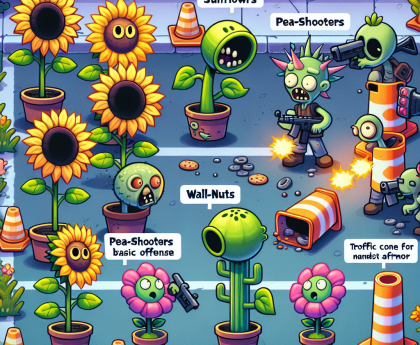“Hay Day” is a popular farming simulation game developed by Supercell, first released in 2012. The game allows players to manage and grow their own farm, raise animals, plant crops, and trade goods with neighbors and friends. As of version 4.4, “Hay Day” continues to offer an engaging and immersive experience with enhanced graphics, new features, and various improvements to gameplay mechanics. Players can enjoy a variety of activities such as fishing, mining, and participating in seasonal events, all while building and customizing their farm to their liking. The game’s social aspect encourages cooperation and competition, making it a dynamic and interactive experience for players of all ages.
Mastering Crop Management: Tips and Tricks for Hay Day Supercell Simulation 4.4
In the ever-evolving world of Hay Day Supercell Simulation 4.4, mastering crop management is essential for achieving success and maximizing your farm’s productivity. As players navigate through the intricacies of this popular farming simulation game, understanding the nuances of crop management can significantly enhance their gaming experience. To begin with, it is crucial to recognize the importance of planning and timing in crop cultivation. Each crop in Hay Day has a specific growth cycle, and knowing the optimal times to plant and harvest can make a substantial difference in your overall yield. For instance, fast-growing crops like wheat and corn can be harvested multiple times a day, providing a steady stream of resources. On the other hand, longer-growing crops such as pumpkins and strawberries require more patience but offer higher rewards. Therefore, balancing short-term and long-term crops is a strategic approach that can ensure a continuous flow of produce.
Transitioning to the next key aspect, crop rotation is another vital technique that can enhance your farm’s efficiency. By rotating crops, players can prevent soil depletion and maintain the fertility of their fields. This practice not only boosts crop yields but also reduces the risk of pests and diseases. For example, alternating between nitrogen-fixing crops like soybeans and nutrient-demanding crops like carrots can help maintain soil health. Additionally, incorporating a variety of crops into your rotation plan can diversify your farm’s output, catering to different market demands and increasing your overall profitability.
Furthermore, efficient use of resources plays a pivotal role in crop management. Water, fertilizers, and farm equipment should be utilized judiciously to maximize productivity. Investing in high-quality fertilizers can accelerate crop growth and improve yields, while proper irrigation techniques ensure that crops receive adequate water without wastage. Moreover, upgrading farm equipment such as tractors and harvesters can streamline the planting and harvesting processes, saving valuable time and effort. By optimizing resource usage, players can achieve higher efficiency and better results in their farming endeavors.
In addition to resource management, understanding market trends and demands is essential for successful crop management. Keeping an eye on the in-game market can provide valuable insights into which crops are in high demand and fetch better prices. By aligning your crop production with market trends, you can capitalize on lucrative opportunities and maximize your profits. For instance, if there is a surge in demand for tomatoes, prioritizing their cultivation can yield substantial financial gains. Staying informed about market dynamics and adjusting your crop strategy accordingly can give you a competitive edge in the game.
Moreover, collaboration with other players can significantly enhance your crop management skills. Joining a neighborhood or cooperative allows you to share resources, exchange tips, and participate in group events. This collaborative approach fosters a sense of community and provides access to valuable knowledge and support. By working together, players can tackle challenges more effectively and achieve collective goals, ultimately improving their individual crop management practices.
In conclusion, mastering crop management in Hay Day Supercell Simulation 4.4 requires a combination of strategic planning, efficient resource utilization, market awareness, and collaboration. By implementing these tips and tricks, players can optimize their farming operations, increase their yields, and achieve greater success in the game. As you continue to refine your crop management skills, you will find yourself better equipped to navigate the complexities of Hay Day and enjoy a more rewarding gaming experience.
Building the Ultimate Farm: Strategies for Success in Hay Day Supercell Simulation 4.4
In the ever-evolving world of mobile gaming, Hay Day Supercell Simulation 4.4 stands out as a premier farming simulation game that captivates players with its intricate blend of strategy, resource management, and community interaction. Building the ultimate farm in this game requires a keen understanding of various elements, from crop rotation to animal husbandry, and a strategic approach to resource allocation. To achieve success, players must navigate through a series of well-planned steps, each contributing to the overall efficiency and productivity of their farm.
Initially, the foundation of a successful farm lies in the careful selection and cultivation of crops. Players should prioritize planting high-yield crops that offer the best return on investment. For instance, wheat and corn are excellent choices for beginners due to their short growth cycles and versatility in crafting various products. As players progress, diversifying crop selection becomes crucial. Incorporating longer-growing crops like pumpkins and strawberries can provide substantial profits, albeit requiring more patience and planning. Transitioning between different crops not only maximizes land use but also ensures a steady supply of raw materials for production.
Equally important is the management of livestock, which plays a pivotal role in the farm’s ecosystem. Chickens, cows, and pigs are essential for producing eggs, milk, and bacon, respectively. These products are not only valuable for direct sale but also serve as key ingredients in crafting higher-value goods. Efficiently managing feed production and ensuring a balanced diet for the animals can significantly enhance their productivity. Additionally, expanding the animal enclosures and upgrading their facilities can lead to increased output, further boosting the farm’s profitability.
Moreover, the strategic placement of production buildings is vital for optimizing workflow and minimizing downtime. Players should aim to cluster related buildings together, such as placing the bakery near the wheat fields and the dairy next to the cow pens. This arrangement reduces the time spent transporting goods and streamlines the production process. Upgrading these buildings is another critical aspect, as higher-level facilities can process more items simultaneously, thereby increasing overall efficiency.
In addition to crop and livestock management, engaging with the in-game community can provide substantial benefits. Joining a neighborhood allows players to participate in cooperative tasks, share resources, and gain access to exclusive rewards. Active participation in events and competitions can yield valuable prizes, including rare items and boosters that can accelerate farm development. Furthermore, trading with other players offers an opportunity to acquire scarce resources and offload surplus goods, fostering a mutually beneficial economy.
Financial management is another cornerstone of building the ultimate farm. Players must judiciously invest their earnings in expanding land, purchasing new equipment, and upgrading existing facilities. Balancing short-term expenditures with long-term investments is crucial for sustained growth. For example, while it may be tempting to spend coins on decorative items, prioritizing functional upgrades can lead to greater returns in the future.
Lastly, continuous learning and adaptation are essential for mastering Hay Day Supercell Simulation 4.4. The game frequently introduces new features, crops, and animals, requiring players to stay informed and adjust their strategies accordingly. Keeping abreast of updates and actively seeking out tips from experienced players can provide a competitive edge.
In conclusion, building the ultimate farm in Hay Day Supercell Simulation 4.4 demands a multifaceted approach that encompasses efficient crop and livestock management, strategic placement of production buildings, active community engagement, prudent financial planning, and a commitment to continuous improvement. By meticulously implementing these strategies, players can transform their virtual farms into thriving agricultural enterprises.
Maximizing Profits: Effective Trading Techniques in Hay Day Supercell Simulation 4.4
In the vibrant world of Hay Day Supercell Simulation 4.4, players are constantly seeking ways to maximize their profits and enhance their farming experience. Effective trading techniques are paramount to achieving this goal, as they allow players to optimize their resources, expand their farms, and ultimately, climb the ranks within the game. To begin with, understanding the market dynamics is crucial. The in-game market operates on supply and demand principles, where players can buy and sell goods to other players. By keeping a keen eye on market trends, players can identify which items are in high demand and adjust their production accordingly. For instance, if dairy products are fetching high prices, it would be prudent to focus on producing more milk and cheese.
Moreover, timing plays a significant role in trading. The market prices fluctuate throughout the day, and savvy players can take advantage of these variations. Selling goods during peak times, when more players are active, can result in higher profits. Conversely, purchasing items during off-peak hours can lead to better deals. Additionally, players should regularly check the roadside shop for bargains and opportunities to sell their goods at premium prices. Another effective trading technique involves diversification. Relying on a single type of product can be risky, as market conditions can change rapidly. By diversifying their production, players can mitigate risks and ensure a steady stream of income. For example, growing a variety of crops and raising different types of livestock can provide a buffer against market fluctuations.
Furthermore, building strong relationships with other players can be highly beneficial. Joining a neighborhood or forming alliances can open up new trading opportunities and provide access to exclusive deals. Players can trade goods with their neighbors, share resources, and even collaborate on larger projects. This sense of community not only enhances the gaming experience but also contributes to more efficient trading. In addition to these strategies, players should also focus on upgrading their facilities and equipment. Investing in better machinery and storage solutions can significantly boost production efficiency and reduce wastage. For instance, upgrading the barn and silo allows players to store more goods, enabling them to take advantage of bulk selling opportunities. Similarly, enhancing production facilities like the bakery or dairy can speed up the manufacturing process, leading to higher output and increased profits.
Moreover, players should not overlook the importance of completing orders and tasks. Fulfilling orders from the truck, boat, or town visitors can yield valuable rewards, including coins, experience points, and vouchers. These rewards can be reinvested into the farm, further enhancing its productivity and profitability. Additionally, participating in events and competitions can provide substantial bonuses and exclusive items that can be traded for significant profits. Lastly, players should always strive to stay informed about updates and new features introduced in Hay Day Supercell Simulation 4.4. The game developers frequently release updates that can impact market conditions and introduce new trading opportunities. By staying abreast of these changes, players can adapt their strategies and continue to maximize their profits.
In conclusion, effective trading techniques in Hay Day Supercell Simulation 4.4 involve a combination of market awareness, timing, diversification, community engagement, facility upgrades, and task completion. By mastering these strategies, players can optimize their resources, enhance their farming experience, and achieve greater success in the game.Hay Day by Supercell is a highly engaging farming simulation game, version 4.4, that offers players an immersive experience in managing and growing their own virtual farm. The game features a variety of activities such as planting crops, raising animals, and trading goods with neighbors and friends. Its vibrant graphics, intuitive controls, and social interaction elements make it a popular choice among casual gamers. The continuous updates and community events keep the gameplay fresh and exciting, ensuring long-term player retention. Overall, Hay Day 4.4 successfully combines strategic planning with casual fun, making it a standout title in the farming simulation genre.





